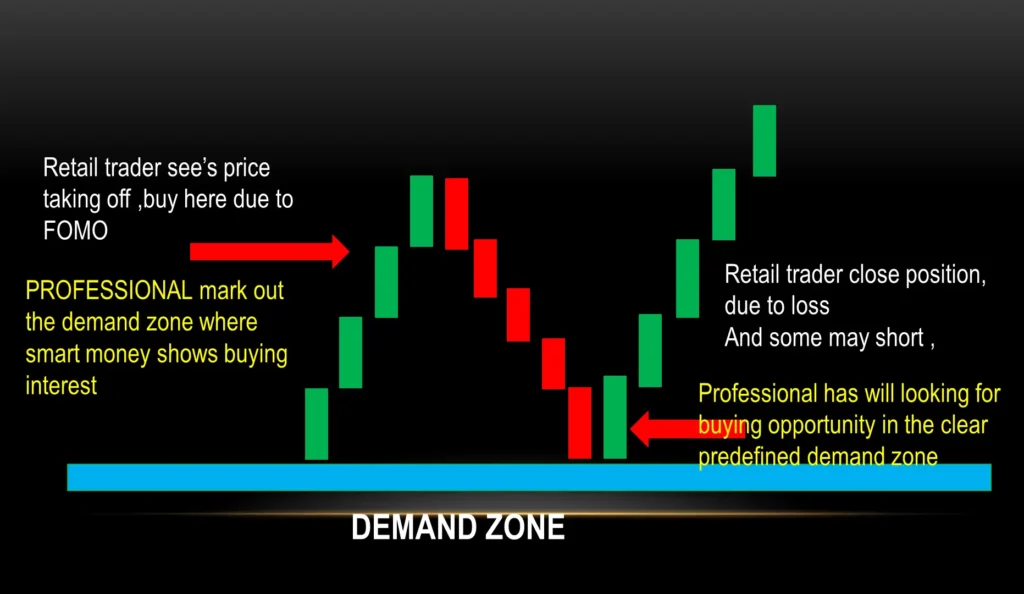
In this article we will discuss in very easy way how to find demand zone. Where big players place their pending orders. How to find that particular candle and exact price.
We have discuss two types of demand zone in last post.
Rally-Boring-Rally and Drop-Boring-Rally.
Steps To Find Demand Zone—
1.Check the pulse and trend of stock on daily and weekly chart. For buying case pulse should be positive and trend should be uptrend.
2. If you are a weekly trader check the pulse and trend at weekly chart and find demand zone at daily time frame or 2hr time frame.
3. If you are a daily trader find check pulse and trend at 2hr time frame and find demand zone at 3 min, 5 min or 10 min or 15 minute time frame.
4. Suppose you are weekly trader you want to find demand zone at 2hr time frame. Than go to daily time frame at last green candle (if last candle is red ignore them).
5. Use the formula for buying case—– Closing Price-ATR. Below this price at 2 hr time frame you will have a demand zone pattern.
6. Check which type demand zone pattern form. Rally-base Rally or Drop- Base-Rally.
Define Your SETS
After findout your demand zone pattern define your “SETS”.
S-Stoploss. Stoploss will be lowest low of pattern. maximum stoploss 0.5% of your capital.
E-Entry. Entry from upper wick of unfilled order candle .
T-Target. Minimum target should be 5 times of stploss. R:R=1:5
S-Size. You have to know how much quantity i will take for stploss will be 0.5%. Example- You take a stock at demand zone 112 and stoploss is 110. Initially You are going 10000 rs. Than for 50rs stoploss your quantities will be 25.
Use always bracket order in demat account. A bracket order contain entry price, stoploss and target price. After creating a bracket order you not need to check price on chart. Price will come at demand zone and your order triggered.
Buying a stock at a demand zone can offer several potential benefits for traders and investors:
- Favorable Risk-to-Reward Ratio: Demand zones are areas where buying interest is expected to be strong, potentially leading to a bounce in stock prices. Buying at these zones allows traders to set their stop-loss orders relatively close to their entry point, thereby minimizing potential losses while aiming for higher gains.
- Potential for Price Reversal: Demand zones often coincide with areas of previous support, where buyers have historically stepped in to buy shares, causing the price to reverse upward. By purchasing at these levels, traders anticipate a similar reaction from buyers, leading to a potential price reversal and subsequent upward movement.
- Confirmation of Technical Analysis: Identifying demand zones involves technical analysis, which can provide traders with added confidence in their trading decisions. When multiple technical indicators align with a demand zone, it strengthens the likelihood of a successful trade.
- Psychological Support: Buying at demand zones can provide psychological comfort to traders, knowing that they are entering a position at a level where buying pressure has historically been strong. This can help traders maintain discipline and confidence in their trading strategy.
- Entry Point for Long-Term Investors: For long-term investors, buying at demand zones can provide an attractive entry point into a stock they believe has strong fundamentals. By purchasing shares at a perceived discount during temporary price declines, investors can potentially enhance their long-term returns.
Overall, demand zones work because they reflect underlying market dynamics and trader behavior. They provide valuable information to traders and investors, helping them make more informed decisions about when to buy or sell an asset.
No matter how much you learn, study or practice, trading psychology is one variable that will dictate your success in the market. Be master in one rule and one tool or one strategy. If You want to master in multiple tools and indicator or etc you will not be master in anything.
